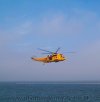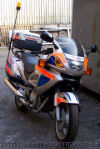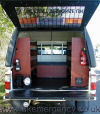Category: OTHERS
CX04 BPK This Ford Focus is used by the SARDA …

CX04 BPK This Ford Focus is used by the SARDA Wales team. An ex-Welsh police dog van, the car still carries police-style blue and yellow battenburg markings.
The rear view of the same car. “Search and Rescue” and “Mountain Rescue” is clearly shown on all sides. On the roof is an equipment storage tube. There is no emergency warning equipment fitted. 
The side view showing the colour scheme and wording on display.
OV53 MXU This smart Audi Allroad is used by the Search …

OV53 MXU This smart Audi Allroad is used by the Search and Rescue Dogs Association (SARDA). It carries red and yellow battenburg markings which continue onto the roof box. Despite the good work that search dog teams do, they are not permitted to use blue flashing lights on their vehicles. It was donated to the South Wales Mountain Rescue Search Dogs by Audi.
UG 98 AA is a Honda ST1100 motorbike used …

UG 98 AA is a Honda ST1100 motorbike used by the RLC. It is fitted with amber flashing lights on the front and an amber strobe on a pole at the rear. It also has red flashing lights to the rear only.
The rear view of the same bike. Notice the simple livery on the bike that makes it look a little like a police bike. However, there is no crest or wording to display the bikes owner or usage.
YJ02 ETK Another Honda is the one shown …

YJ02 ETK Another Honda is the one shown right. This one has a civilian registration and a yellow stripe livery. The rider in high-visibility jacket gets his helmet out from one of the panniers.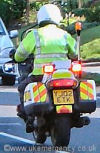
The rear view, showing the red flashing lights in use on the public roads. Here it is escorting a large tank transporter.
WX57 DSU This is one of the Emergency Response Units …
WX57 DSU This is one of the Emergency Response Units for use on the London Underground. It is a Mercedes Atego with John Dennis Coachbuilders bodywork. It is used to restore services after breakdowns and carries a range of equipment to do so. In the lockers are water pumps, jaws of life, airbags, chainsaws, generators, lighting and refreshments for the workers. It weighs 11 tonnes and cost £140,000. The 10 units are based at Acton, Camden, Vauxhall and Tottenham Hale.
Update: Since late 2009 various changes have been made to the location of these 10 vehicles. They are now at Camden (2), Acton (4), Battersea (2) and 2 training vehicles. Tottenham Hale base closed on 2nd September 2009 and Vauxhall also closed and was replaced by a new location at Battersea.
BV55 UEE is the only rail incident command unit …

BV55 UEE is the only rail incident command unit run by Network Rail. The Vauxhall truck is based next to Doncaster station it is available 24 hours a day to attend major incidents on the railways. 
The rear view of the RICU which is fitted with satellite communications equipment on the roof. This vehicle is supported by 5 Rail Incident Control Point vehicles and these are further supported by 5 Rail Incident Support Unit vehicles (all Mercedes Sprinters).
W209 YHJ This NR Ford Transit is a Rail Incident Command …

W209 YHJ This NR Ford Transit is a Rail Incident Command Vehicle. In this photograph it has been deployed to coordinate a rescue and has its communications antenna raised. Other NR and police vehicles can be seen in the background.
The rear view of the same Transit, showing the external generator. In the background you can see the exercise that the vehicle is helping to coordinate at a level crossing.
RE52 BCV This NR Toyota Hi-Lux diesel is decked …

RE52 BCV This NR Toyota Hi-Lux diesel is decked out in yellow and blue battenburg markings, very similar to a police vehicle. The only difference is that this car’s livery is not reflective. The NR logo and car’s use are shown to the rear.
The rear view of the same car. There are two doors on the back, one opening upwards and the other downwards, to gain access to the equipment carried.
KT04 PXN This is a Clapham Junction (London) based …

KT04 PXN This is a Clapham Junction (London) based Network Rail Ford Transit Connect. It is call-sign RR39 and operates as a rapid response unit.
The rear and offside view. This type of vehicle has replaced some Toyota Hi-Lux’s (shown below) in urban areas where the 4×4 capabilities are not required.
This overhead shot of a Toyota Hi-Lux ‘Rail Incident …

This overhead shot of a Toyota Hi-Lux ‘Rail Incident Response Unit’ shows off the roof markings. The call sign is RR15 (Romeo Romeo One Five) which is shown on both front wings and the roof. The orange spot on top of the cab helps to identify it as a rail response vehicle. All of these vehicles are fitted with satellite tracking devices so the control room knows where they are.
HD51 LHH In the next few photographs we take a look …

HD51 LHH In the next few photographs we take a look around this Network Rail Ford Transit ‘Rail Command Unit’. It is used to attend major incidents on the railways. It is a high-roof, long-wheelbase model with amber flashing lights behind the front grille.
The rear view. It is decked out in orange and blue battenburg markings, with gaps between them.
On the roof is an extending Nightscan floodlight mast (with cctv camera), a radio mast, video and satellite facilities (to receive pictures from a helicopter).
Looking down onto the roof, you can see how the floodlights are stowed when the vehicle is in motion.
Inside, we can see the TV to see the cctv pictures, as well as the video to record them alongside other flush-mounted equipment.
The vehicle also acts as a mobile command centre at railway incidents, offering an office equipped with phone, fax and tracking facilities.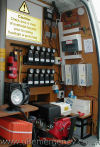
Opening the rear doors of the Transit reveals an array of useful equipment, including lights and a generator. The controls for the telescopic masts can also be seen.
The Rail Command Unit also has a trailer which complements its work. Carrying the same livery, it carries an inflatable shelter which fits alongside the passenger side of the van. The shelter is used to extend the amount of covered space there is for the command centre.
The other side of the shelter. In this scene from an exercise an older Ford Transit is being used. It carries ‘Railtrack’ wording, the predecessor of Network Rail, and ‘Rail Incident Command Vehicle’.







